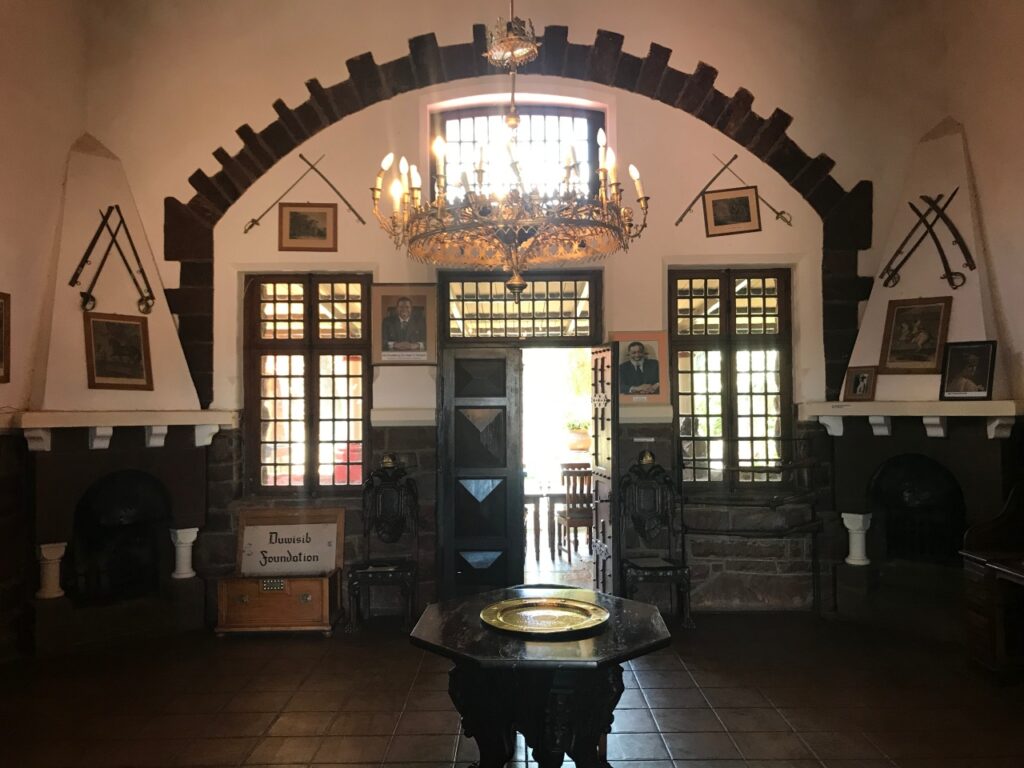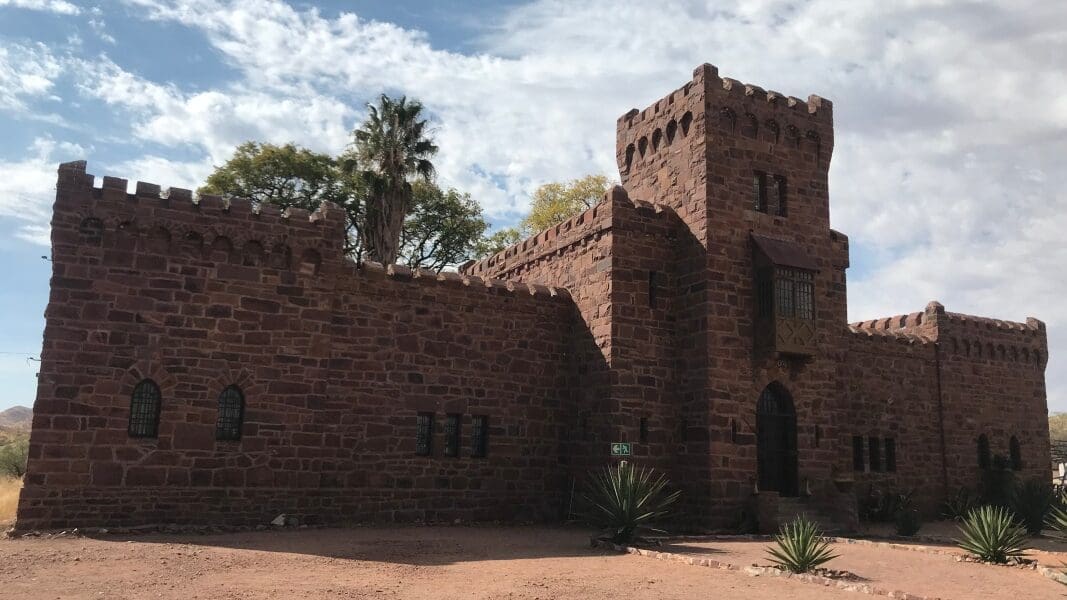Duwisib Castle: A Relic of Love, Ambition, and the Desert
Embarking on a journey through Namibia’s sprawling farmlands and vast deserts, the sight of a castle nestled within this stark landscape might seem improbable. Yet, rising against the backdrop of the semi-arid Southern Namib region stands Duwisib Castle, a grand pseudo-medieval fortress. With its distinctive architecture and remote setting, this landmark tells a fascinating tale interwoven with love, ambition, and history’s turbulent twists and turns.
The Visionary Behind the Castle: Captain Hans Heinrich von Wolf
The story of Duwisib Castle begins with its creator, Captain Hans Heinrich von Wolf, a man driven by a unique vision. Born in 1873 in Dresden, Germany, von Wolf became an officer in the German military and, after establishing his career, found himself stationed in the African colony of German South-West Africa (now Namibia). Drawn by the continent’s vast landscapes and rich potential, von Wolf harbored dreams of establishing his legacy far from the familiar European territories.
In 1907, after his military service, von Wolf returned to Germany. There he married Jayta Humphrey, the stepdaughter of the American consul in Dresden, on April 8, 1907. Their marriage marked the beginning of a new chapter, and they decided to make German South-West Africa their home. To fulfill their shared ambitions, they acquired an enormous expanse of farmland stretching over 55,000 hectares. But von Wolf’s vision wasn’t limited to farming; he envisioned a castle — a grand estate in the desert that would signify his legacy and offer his bride a European-style residence amidst Africa’s remote landscapes.
Building Duwisib Castle: A Testament of Determination
With grand aspirations, von Wolf enlisted the help of Wilhelm Sander, a prominent German architect, to bring his dream to life. Sander was known for his works in the German colonial territories, and von Wolf entrusted him with the design of the castle, ensuring it would embody the characteristics of a traditional European fortress while harmonizing with the rugged Namibian terrain.
Construction of Duwisib Castle began in 1907. The castle’s structure required meticulous planning and extensive resources. The red sandstones that form its walls were sourced from a nearby quarry, approximately two kilometers away. Transporting these massive stones through the harsh desert landscape was no small feat. The stones were loaded onto ox wagons and hauled to the construction site, reflecting the perseverance and dedication that went into the castle’s creation.
The grandeur of the project didn’t end with the stonework. Von Wolf imported an array of fine furnishings and decor items from Germany to lend a refined European elegance to the castle’s interior. To ensure the highest quality of craftsmanship, he hired skilled masons and artisans from various European countries, including Italy, Sweden, and Ireland. The castle’s interior boasted carefully carved wooden furniture, exquisite tapestries, and impressive masonry, creating a stark contrast with the stark African desert outside.
The Castle as a Home: An Oasis in the Namib Desert
As construction progressed, the castle gradually became a home — an unexpected oasis of opulence in the middle of the vast Namibian desert. Duwisib Castle covered an expansive 900 square meters and featured a spacious courtyard, designed as a sanctuary for relaxation and leisure. Its interior layout, with lofty ceilings and spacious rooms, offered a respite from the harsh heat of the desert, while large windows allowed cool breezes to circulate through the building.
Duwisib was meant to be more than just a residence. Von Wolf dreamed of developing a flourishing horse stud on the surrounding lands, blending European agricultural techniques with the unique demands of the African environment. His ambition reflected a desire not only to create a self-sustaining estate but to contribute to the economic growth of the colony. The castle became a symbol of von Wolf’s commitment to both his wife and his adopted homeland, embodying their shared dream of a prosperous and enduring legacy.

World War I: The Turning Point
In 1914, with the castle completed and the estate established, von Wolf and Jayta planned a trip to Europe. The purpose of this journey was to expand their horse stud operation by acquiring additional breeding stock. However, fate had other plans. The outbreak of World War I drastically altered their itinerary and marked the beginning of a sequence of events that would eventually lead to the downfall of their African dream.
As war broke out, von Wolf, a patriotic German, felt compelled to rejoin the German military. The couple’s ship was redirected to Rio de Janeiro, where they found themselves stranded in Brazil, uncertain about how they would proceed. Jayta, holding American citizenship, was able to secure passage to Europe on a Dutch vessel, but due to the escalating hostilities, von Wolf faced considerable difficulty returning to Germany.
According to legend, the resourceful couple devised an unusual plan to avoid detection. Jayta allegedly hid von Wolf in her cabin throughout the voyage. To maintain secrecy, she purportedly ordered meals for two, feigning an exceptional appetite to prevent suspicion among the crew. This daring ruse succeeded, and they safely reached Europe, where von Wolf promptly rejoined the German military.
Tragically, von Wolf’s return to the front lines proved fatal. He was deployed to the infamous Somme battlefield in France, where, in 1916, he lost his life in combat. The untimely death of her husband marked the end of Jayta’s connection to Namibia and Duwisib Castle. Heartbroken and widowed, she never returned to the land where they had nurtured their shared dreams. The castle, which had been a symbol of their love and ambition, now stood abandoned, a silent monument to their unrealized aspirations.
A Castle Preserved in Time: Duwisib’s Legacy
Over time, Duwisib Castle became a relic, weathering the harsh elements of the Namibian desert yet retaining its architectural grandeur. Despite the abandonment, the castle’s structure remained remarkably intact, preserving both its physical and historical significance. The Namibian government eventually recognized the cultural and historical value of Duwisib Castle and declared it a national monument. This recognition safeguarded the castle’s legacy, ensuring that its stories of love, ambition, and loss would endure for future generations.
Today, Duwisib Castle serves as a museum, welcoming visitors from around the world who are intrigued by its unique history. As guests wander through its halls, they can explore the original furniture, artifacts, and decorations that once adorned the home of Baron von Wolf and Jayta Humphrey. Each room holds traces of the couple’s life, providing a glimpse into the past and a window into the lives of early European settlers in Africa.
A Visitor’s Experience: Stepping Back in Time
Visitors to Duwisib Castle often marvel at the juxtaposition of its medieval-style architecture against the vast, sun-scorched desert. The fortress, with its crenelated towers and red sandstone walls, appears as if it were transported from Europe and placed, almost magically, in the African wilderness. The spacious courtyard, surrounded by thick walls, offers a serene retreat, inviting visitors to pause and reflect on the castle’s storied past.
Inside, the castle is an immersive experience of early 20th-century life. The preserved rooms, furnished with European antiques, evoke the elegance and opulence the von Wolfs sought to bring to the remote desert. The dining hall, with its heavy wooden tables and finely carved chairs, gives a sense of the grandeur with which the couple lived, while the library showcases their intellectual pursuits and interest in literature and art. Each artifact tells a fragment of the story, painting a vivid picture of the lives that once animated these stone walls.
Enduring Symbolism: The Legacy of Duwisib Castle
Duwisib Castle remains more than just a historical structure; it is a symbol of the dreams and challenges faced by early settlers in Africa. Its survival speaks to the resilience of human ambition and the lengths to which individuals go to realize their visions. For von Wolf and Jayta, the castle was a testament to their love, an attempt to create a sanctuary in the unfamiliar and unforgiving desert.
The castle also serves as a reminder of the fleeting nature of life and the impact of historical events on individual destinies. The outbreak of World War I, a conflict that reshaped entire continents, disrupted the lives of the von Wolfs and altered the trajectory of their legacy. Yet, despite its abandonment and the passing of over a century, Duwisib Castle continues to stand, echoing the stories of those who built it and preserving their memory in its sandstone walls.
Conclusion: Duwisib Castle as a Window into the Past
Duwisib Castle is a rare and captivating landmark in Namibia, embodying the romance, ambition, and tragedy of its creators. It offers a unique perspective on the lives of early European settlers and the challenges they encountered in adapting to Africa’s vast and unfamiliar landscapes. The castle’s remote location, preserved artifacts, and fascinating history invite visitors to reflect on the resilience of the human spirit and the enduring power of dreams. As a national monument, Duwisib Castle stands as a testament to an era gone by, a legacy that continues to captivate and inspire all who venture to its desert home.
Planning to visit Duwisib Castle? Reach out to us for more information, or explore a customized safari experience in Namibia!
What is the history behind Duwisib Castle in Namibia?
Duwisib Castle was built in 1909 by German Captain Hans Heinrich von Wolf, who intended it as a grand residence for himself and his American wife, Jayta Humphrey. Designed by renowned architect Wilhelm Sander, the castle was constructed using local sandstone and imported furnishings, creating an impressive European-style fortress in Namibia’s semi-arid desert. Unfortunately, von Wolf was killed during World War I, and the couple’s dream was left unfinished. Today, the castle stands as a historical monument open to the public, showcasing early 20th-century life and colonial architecture in Namibia.
How do I get to Duwisib Castle?
Duwisib Castle is located in the Namib Desert, about 70 kilometers from the small town of Maltahöhe in southern Namibia. The castle is accessible by car, with well-marked routes leading from nearby towns. Many visitors choose to include Duwisib Castle in a broader Namibian road trip, often paired with destinations like Sossusvlei and Fish River Canyon. For those wanting a guided experience, several safari operators in Namibia offer excursions that include the castle as a point of interest.
What can I expect when visiting Duwisib Castle?
Visitors to Duwisib Castle can explore its unique pseudo-medieval architecture, spacious courtyard, and interior rooms furnished with original pieces from the early 1900s. Each room is preserved to reflect the opulence and design aesthetic of the time, making it a fascinating glimpse into the life of early settlers in Namibia. The castle is also set in a beautiful desert landscape, perfect for photography and enjoying scenic views. A small museum inside offers historical context on Captain von Wolf and the castle’s construction.
Is there an entrance fee to visit Duwisib Castle, and what are the visiting hours?
Yes, there is an entrance fee for visitors to Duwisib Castle, which helps maintain and preserve this historic site. Ticket prices are generally affordable, though they may vary slightly for international tourists. The castle is typically open daily from 8:00 AM to 5:00 PM, though it’s advisable to confirm hours in advance, as times may vary slightly depending on the season or special events.


You must be logged in to post a comment.